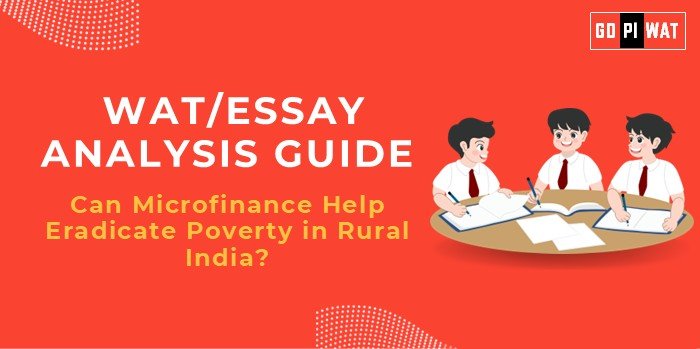📋 Written Ability Test (WAT)/Essay Analysis Guide
Topic: Can Microfinance Help Eradicate Poverty in Rural India?
🌟 Understanding the Topic’s Importance
Microfinance intersects financial inclusion and poverty alleviation, making it a critical subject for B-schools. It relates to social entrepreneurship, rural development, and economic policy, offering insights into sustainable development practices.
⏱️ Effective Planning and Writing
- Time Allocation:
- 📝 Planning: 5 minutes
- ✍️ Writing: 20 minutes
- 🔍 Review: 5 minutes
💡 Introduction Techniques
- Contrast Approach:
“While microfinance has reached over 7 crore borrowers and boasts a gross loan portfolio of ₹4.33 lakh crore, its high interest rates and over-indebtedness pose significant challenges to poverty alleviation in rural India.”
- Timeline Approach:
“From its inception in the 1980s as a grassroots initiative to its transformation into a ₹4.33 lakh crore industry in 2024, microfinance has evolved to become a key player in rural poverty alleviation, albeit with notable challenges.”
📊 Structuring the Essay Body
🏆 Achievements
- 👩👧👧 Women’s Empowerment: Approximately 85% of beneficiaries are women, fostering entrepreneurship and financial inclusion.
- 📈 Job Creation: Enabled over 12 million rural micro-enterprises, significantly impacting rural economies.
- 💳 Access to Finance: ₹1.25 lakh crore disbursed to first-time borrowers.
- 📚 Financial Literacy: SHGs and MFIs train millions annually, improving financial practices in rural areas.
⚠️ Challenges with Comparative Analysis
- 💸 High Interest Rates: Often 20–30%, much higher than regulated systems like Bangladesh’s Grameen Bank (12–15%).
- 📉 Loan Defaults and Over-Indebtedness: Cases like Andhra Pradesh’s microfinance crisis highlight the risk of multiple borrowing and poor repayment capacity.
- 🌍 Limited Access in Remote Areas: Despite BharatNet’s efforts, rural connectivity challenges limit the reach of digital microfinance.
🚀 Future Outlook
- 📱 Fintech Integration: Mobile-based platforms can lower costs and improve transparency.
- 📜 Regulatory Reforms: Policies to cap interest rates and strengthen borrower protection are vital.
- 🤝 Public-Private Partnerships: Collaborations can enhance last-mile delivery of services.
📄 Concluding Effectively
- Balanced Approach:
“Microfinance has played a transformative role in rural India by empowering women and fostering entrepreneurship. However, its long-term success depends on addressing interest rate challenges and ensuring regulatory oversight to protect borrowers.”
- Future-Focused:
“With strategic integration of fintech, effective policy regulation, and global benchmarking, microfinance can become a cornerstone of sustainable rural poverty alleviation in India.”
✍️ Sample Short Essays
- Balanced Perspective:
“Microfinance has empowered millions of women and created micro-enterprises in rural India. However, high interest rates and over-indebtedness challenge its effectiveness. Addressing these limitations through regulatory reforms and fintech integration can unlock its full potential.”
- Solution-Oriented:
“Lowering interest rates, promoting financial literacy, and leveraging fintech are key to making microfinance a sustainable solution for rural poverty alleviation.”
- Global Comparison:
“India’s microfinance sector, with its ₹4.33 lakh crore portfolio, has made commendable strides. Learning from Bangladesh’s Grameen Bank model can help address challenges like high interest rates and ensure greater inclusivity.”
🌟 Recommendations for Sustainable Progress
- 💵 Interest Rate Caps: Establish a regulated cap on interest rates to make microfinance loans more affordable.
- 📱 Digital Transformation: Use mobile-based platforms to reduce operational costs and increase transparency.
- 🎓 Financial Literacy Campaigns: Expand training programs for rural borrowers to enhance repayment rates and entrepreneurial success.
- 📜 Focused Policies: Implement borrower protection frameworks to prevent over-indebtedness and exploitation.


